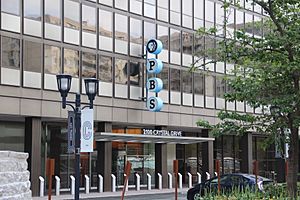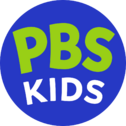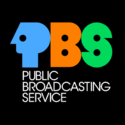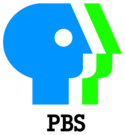PBS facts for kids

Logo used since 2019.
|
|
| Type |
|
|---|---|
| Country |
|
| Broadcast area |
|
| Affiliates | List of member stations |
| Headquarters | Arlington County, Virginia, U.S. |
| Programming | |
| Language(s) |
|
| Picture format | |
| Ownership | |
| Owner | PBS's member public television stations |
| Key people |
|
| History | |
| Founded | November 3, 1969 |
| Launched | October 5, 1970 |
| Founder |
|
| Replaced | National Educational Television (1952–1970) |
| Links | |
| Webcast | (US only) |
| Availability | |
| Streaming media | |
| Service(s) | DirecTV Stream, Hulu + Live TV, Prime Video Live TV, YouTube TV |
The Public Broadcasting Service (PBS) is a special TV network in the United States. It's a public broadcaster, which means it's not like regular TV channels that show lots of commercials. Instead, PBS offers programs for free to everyone. It's based in Arlington, Virginia.
PBS is a nonprofit organization. This means it doesn't try to make money for owners. Its main goal is to provide educational programs to public TV stations across the U.S. You might know some of its famous shows like Nature, Nova, Frontline, PBS News Hour, Masterpiece, Mister Rogers' Neighborhood, Sesame Street, Barney & Friends, and Arthur. Some PBS stations can even be watched in parts of Canada.
PBS gets its money from different places. This includes fees from its many local TV stations, money from the Corporation for Public Broadcasting, and donations from people and groups. All the money for shows has to follow rules to make sure the programs are fair and not influenced by who paid for them. PBS has over 350 local TV stations that are part of its network. Many of these stations are owned by schools, universities, or other nonprofit groups.
Contents
History of PBS: How It Started

PBS was created on November 3, 1969. It was started by a few important people: Hartford N. Gunn Jr., John Macy, James Day, and Kenneth A. Christiansen.
The network officially began showing programs on October 5, 1970. It took over many of the jobs from an older network called National Educational Television (NET). In 1973, PBS joined with another group called Educational Television Stations.
PBS and the Watergate Hearings
A big moment for PBS happened on May 17, 1973. This was when the United States Senate Watergate Committee started its public meetings about the Watergate scandal. PBS broadcast these meetings all over the country. Robert MacNeil and Jim Lehrer were the commentators. Even though other big TV networks showed parts of the hearings, PBS showed them again in the evening. For seven months, these nightly broadcasts were very popular. They helped make the new PBS network well-known.
Growing Popularity and Trust
In 1994, a study looked at how popular and trusted different charities were. PBS was ranked as the 11th "most popular charity/non-profit in America." Many Americans said they "loved" or "liked a lot" PBS.
Since the mid-2000s, surveys have consistently shown that PBS is the most-trusted national institution in the United States. A study from 2016-2017 found that 80% of all U.S. TV homes watched PBS programs at some point during the year. It's important to remember that not all shows on public TV stations come from PBS. Many come from local stations or other groups. This can sometimes confuse viewers.
In December 2009, PBS started being included in Nielsen ratings reports. This meant it was measured alongside big commercial TV networks.
PBS in the Digital Age
In May 2011, PBS announced a change to how it showed sponsor messages. It started putting short messages from companies and foundations during breaks in shows like Nature and NOVA. This was a new way to help fund the programs.
Also in 2011, PBS launched apps for phones and tablets. These apps let people watch full-length videos on their mobile devices.
PBS also expanded internationally. "PBS UK" started in the United Kingdom on November 1, 2011, showing American documentaries. It later changed its name to "PBS America" and became available in other parts of Europe and Australia.
In 2012, PBS faced a challenge from online videos like YouTube. Jason Seiken, a Senior Vice President, warned that PBS needed to adapt. He helped create PBS Digital Studios. This studio started making educational videos with a "YouTube style." One of their first big hits was a fun, auto-tuned version of the Mister Rogers' Neighborhood theme song. By 2013, PBS was getting huge numbers of video views online. PBS.org even had more traffic than the websites of CBS, NBC, and ABC. PBS Kids.org also became the top U.S. children's site for videos.
In May 2013, PBS shows became available on Roku streaming players. There are separate channels for "PBS" and "PBS Kids" content. Some special content is available with a PBS Passport membership.
PBS has continued to partner with streaming services. In July 2016, Amazon Prime Video started carrying many PBS Kids series. In May 2019, PBS Kids launched on DStv and GOtv in Africa. In 2019, YouTube TV also began carrying PBS programming.
In 2020, PBS moved its headquarters to a new building in Crystal City, Virginia. On August 4, 2020, Amazon Prime Video added a "PBS Documentaries" package. PBS also started offering a free livestream of its member stations on its website and apps on September 3, 2020.
More recently, in July 2021, a PBS Julia Child channel was added to Pluto TV and Tubi. In January 2023, channels like "PBS Antiques Roadshow" and "PBS Nature" were added to other free streaming platforms. New channels like "PBS Food" and "PBS History" launched in late 2023. In April 2024, "PBS Retro" was added to Roku, showing PBS Kids shows from the 70s, 80s, and 90s.
How PBS Works
PBS is a non-profit and educational TV network. It gives TV shows and services to its many local stations. These local stations actually own the network together. Unlike commercial TV networks, each PBS station is in charge of making its own local shows. These can include local news, interviews, and community programs. These local shows add to the programs that PBS provides nationally.
In commercial TV, local stations give up some of their ad time to show network programs. But PBS stations pay fees for the shows they get from the national organization. This means PBS stations have more freedom to decide when to show programs. So, a PBS show might air at different times depending on where you live. However, PBS does have a rule called "common carriage." This means most stations try to show the main evening programs at the same time. This helps PBS promote its shows across the country.
Even though PBS has a set schedule, local stations can choose to show programs at different times or not at all. Most PBS stations will show programs at different times. Once PBS agrees to distribute a show, PBS usually has the rights to show it again for a certain time. But the people who made the show can still sell it on DVDs or in books.
PBS Programs: What You Can Watch
PBS shows a wide variety of programs, especially in the evenings. You can find shows about:
- Arts: Great Performances
- Drama: Masterpiece, Downton Abbey
- Science: Nova, Nature
- History: American Experience, American Masters, Antiques Roadshow
- Music: Austin City Limits
- News and Current Events: Frontline, PBS NewsHour, Washington Week
- Documentaries: P.O.V., Independent Lens
- Home Improvement: This Old House
- Interviews: Amanpour & Company
In 2012, PBS started organizing its evening shows by type. For example, drama shows might be on Sundays, and science shows on Wednesdays.
Who Makes PBS Shows?
Unlike some other networks, PBS doesn't have its own central team that makes all its shows. Instead, all the programs you see on PBS are made by other groups. Many are created by individual PBS stations. For example, WGBH-TV in Boston makes many popular shows. These include American Experience, Arthur, Masterpiece Theatre, Nova, and Frontline.
News programs are made by stations like WETA-TV in Washington, D.C. (for PBS News Hour) and WNET in New York City. WNET also produces shows like Nature and Cyberchase. PBS sometimes works with other networks too, like CNN International for Amanpour & Company.
PBS stations are also known for showing British TV programs. These include dramas, comedies, and science fiction shows from the BBC and other sources. Examples are Downton Abbey, Are You Being Served?, Keeping Up Appearances, Monty Python's Flying Circus, and Doctor Who. British and Canadian shows often appear on PBS.
PBS is not the only place that provides shows to its member stations. Other groups like American Public Television also distribute programs. Local PBS stations also make their own shows. Some of these local shows then get shown across the country.
Reruns of shows not originally made for public TV are rare on PBS. A big exception is The Lawrence Welk Show, which has been airing reruns since 1986. Reruns of shows originally made for public TV are common, especially for older shows. Children's programs like Clifford the Big Red Dog are also rerun often.
PBS Kids: Learning and Fun
PBS Kids is the name for all the children's programs shown by PBS. It started as PTV on July 11, 1994. The PBS Kids channel launched in 1999. It stopped in 2005 but came back in 2017.
PBS Kids shows are made to both educate and entertain young viewers. PBS and its stations follow rules about educational programming. Many stations also used to show distance learning programs for schools. Now, with digital TV, these programs are often on special subchannels or online.
As of February 2023, the PBS Kids block on the main channel was shortened. It now runs for eight hours in the mornings. This change was made to offer more general shows in the afternoons. It also helps move kids' programming to online streaming services.
PBS Kids also shows programs from other countries, like British series from the BBC. Some PBS Kids shows have even been shown on commercial TV channels.
Sports on PBS
Many local PBS stations show high school and college sports. However, the national PBS network usually doesn't show major sporting events. This is because the rights to broadcast these events have become very expensive. Also, many college sports are now shown on special cable channels owned by athletic conferences.
In the past, from 1976 to 1989, PBS showed German soccer matches. PBS also used to show tennis and Ivy League football games.
How PBS is Managed
A group called the board of directors is in charge of PBS. They set the rules and policies. The board has 27 members. Fourteen are professional directors (who manage TV stations), and 12 are general directors (from outside the organization). The PBS president is also on the board. All board members serve for three years and don't get paid. The PBS stations choose the professional directors. The board chooses the general directors and the PBS president.
PBS Member Stations: Local Connections
As of March 2015, PBS has 354 TV stations that are members. These stations are in all 50 states, Washington D.C., and four U.S. territories. This means PBS is the only TV network in the U.S. that has stations in every single state. PBS reaches about 93.74% of all homes in the United States.
PBS stations are usually run by nonprofit groups, state governments, local governments, or universities. This is different from how big commercial TV networks work today. In some states, a group of PBS stations works together as one big "subnetwork." For example, Alabama Public Television is a state-wide network.
Sometimes, a city might have more than one PBS station. For example, the Los Angeles area has four different PBS stations. For these cases, PBS uses a plan that decides how many PBS-distributed programs each station can show. The main station usually shows more PBS programs, while other stations show fewer. Unlike public broadcasters in most other countries, PBS doesn't own any of its stations. This is because of how PBS stations started and old broadcasting rules.
Stations That Make PBS Shows
Most PBS member stations have made at least some shows that are shown across the country. Here are some of the stations that regularly produce programs for the national PBS network:
- WGBH-TV (Boston): Arthur, NOVA, Masterpiece, Frontline, Curious George
- WNET (New York City): Nature, PBS NewsHour Weekend, Cyberchase, Amanpour & Company
- WETA-TV (Washington, D.C.): PBS News Hour, Washington Week, America's Test Kitchen, This Old House
- WTTW (Chicago): Nature Cat, WordWorld
- Maryland Public Television: MotorWeek, Julia Child
- KLRU (Austin): Austin City Limits
- KCET (Los Angeles): Sid the Science Kid
- KQED (San Francisco): The Cat in the Hat Knows a Lot About That!
- Oregon Public Broadcasting: Rick Steves' Europe
- WQED (Pittsburgh): Mister Rogers' Neighborhood
- Twin Cities PBS (Minneapolis/St. Paul): SciGirls, Hero Elementary
- South Carolina ETV: The Magic School Bus
Other PBS Networks
| Network | What It Offers |
|---|---|
 PBS Kids |
A channel that provides children's television programs. It started as a 24/7 channel in 1999, stopped in 2005, and then came back in 2017. |
| PBS Satellite Service | A 24-hour channel that offers a mix of programs from the main PBS service. It's used by satellite TV providers. |
PBS has also created other TV networks, sometimes with other media companies. PBS YOU was a learning and how-to service that ran from 2000 to 2006. It was mostly replaced by Create, which is similar. The 24-hour PBS Kids Channel has had two versions. World started in 2007 and shows news and documentaries.
Some of these channels are available on digital cable, satellite TV, or as free channels on digital signals from some PBS stations.
Other Public Broadcasting Networks
While not run by PBS itself, other public broadcasting networks are also available and carried by PBS member stations. These include:
| Channel | What It Offers | Who Runs It |
|---|---|---|
| Create | Educational and artistic programs | American Public Television |
| World | News and documentaries | |
| First Nations Experience | Programs about Indigenous cultures | San Bernardino Community College District |
Many PBS stations also have special channels that show full-time coverage of state government events. This is similar to how C-SPAN covers the federal government.
PBS Look and Feel: The Logos
PBS got its first special logo in 1971. It was a colorful wordmark of the letters "PBS." The letter "P" was designed to look like the side of a human face. This "P" face became known as the "P-Head" and was used in all later PBS logos.
In 1984, PBS introduced a new version of the logo. The designers wanted a symbol that showed the idea of "public television" for everyone. They flipped the "P" face to look to the right. They also repeated the outline of the face many times. This was meant to show a "multitude" of people. This symbol was later called "Everyone." The repeated faces also suggest different cultures and PBS's goal to serve the public.
This logo has been used in different ways since then. From 1998, the logo was often shown in white on a circle.
On November 4, 2019, for PBS's 50th anniversary, they revealed a new look. The "P" face logo was slightly changed. A new special font called PBS Sans was created for the logo and other branding. Electric blue and white became the main colors. PBS is helping its local stations update their logos to match the new look. Some stations, like Wisconsin Public Television, even changed their names to include "PBS" in them.
See also
 In Spanish: PBS (Estados Unidos) para niños
In Spanish: PBS (Estados Unidos) para niños
- American Public Media
- List of United States over-the-air television networks
- PBS America
- Public Radio International
- Public, educational, and government access (PEG)
- Television in the United States
Similar Public Broadcasting Services Around the World
These public broadcasters and channels also focus on educational programming, like PBS:
 TVO (formerly TVOntario), Knowledge Network
TVO (formerly TVOntario), Knowledge Network China Education Television
China Education Television
 Arte
Arte France 5
France 5 ARD-alpha
ARD-alpha Educational Broadcasting System
Educational Broadcasting System Swedish Educational Broadcasting Company (UR)
Swedish Educational Broadcasting Company (UR)











